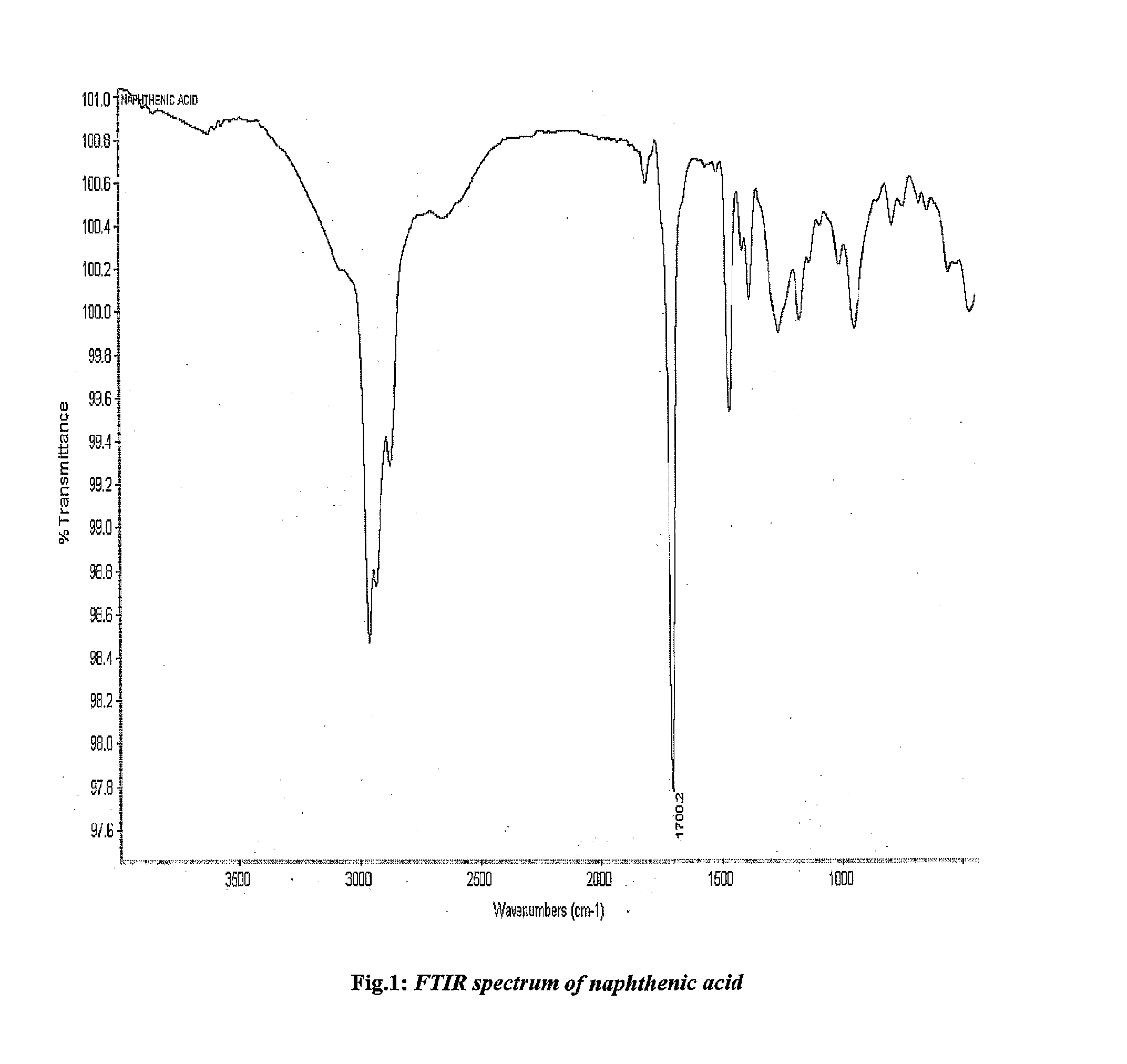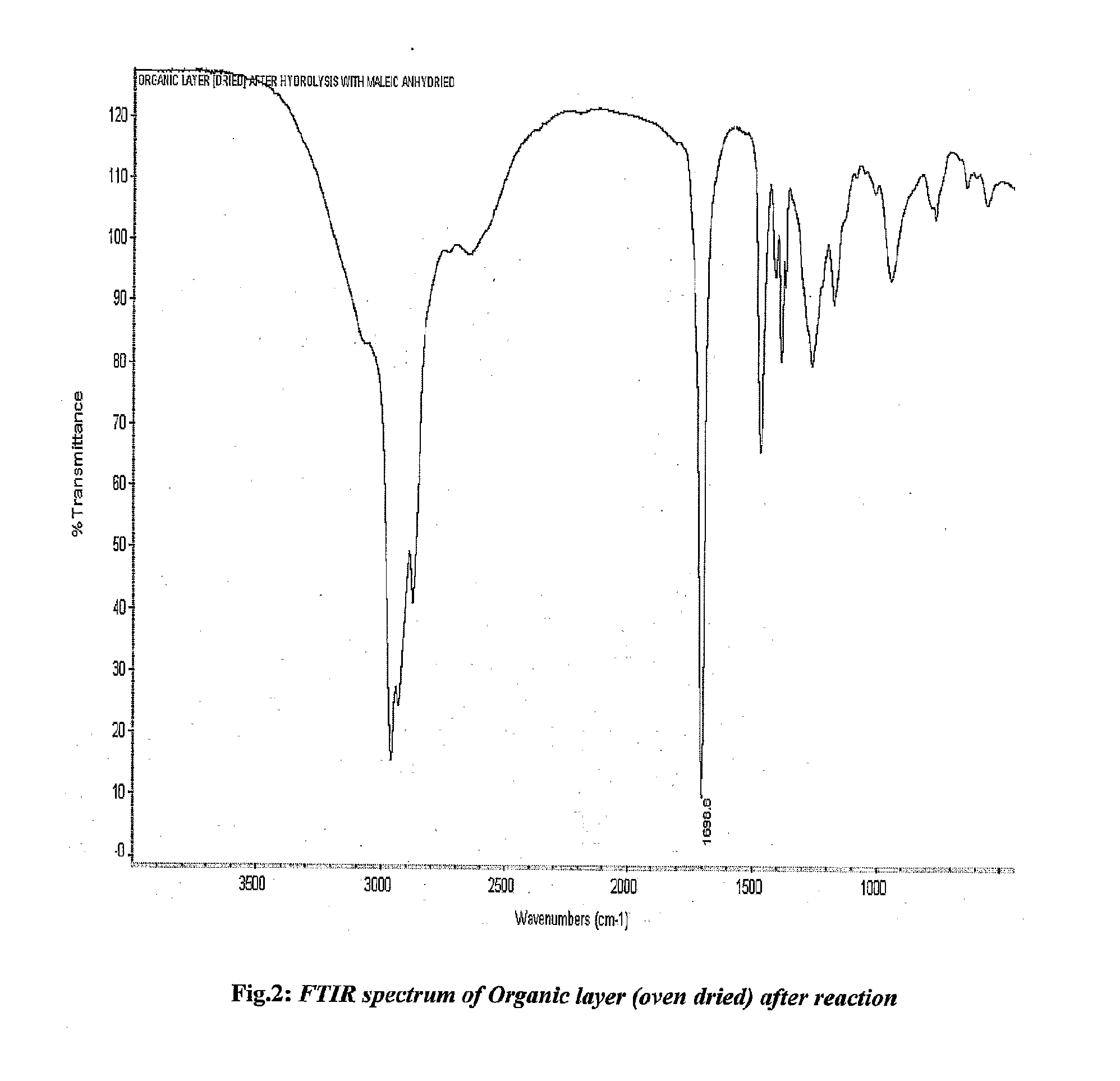Method of removal of calcium from hydrocarbon feedstock
a hydrocarbon feedstock and calcium technology, applied in the petroleum industry, acid-containing liquid treatment, petroleum industry, etc., can solve the problems of heat exchanger fouling, catalyst poisoning, and difficulty in effluent treatmen
- Summary
- Abstract
- Description
- Claims
- Application Information
AI Technical Summary
Benefits of technology
Problems solved by technology
Method used
Image
Examples
example 1
[0068]Procedure: Maleic anhydride, demineralized water and Ca-naphthenate in toluene were charged into a 250 ml round bottom flask, equipped with thermometer pocket and water condenser, and was refluxed for 2 hours. After 2 hours it was cooled to room temperature and the contents of the round bottom flask were poured into a separating funnel. Two separated layers that is top hydrocarboneous layer and bottom aqueous were collected and analyzed as mentioned below. The aqueous layer was analysed for pH, and Calcium content was analysed by using Ion Chromotography. The hydrocarboneous layer was dried to remove toluene and the dried sample was analysed by Fourier Transform Infrared Spectrometer (FTIR) as discussed below, and for Calcium content by using ICP technique (INDUCTIVE COUPLED PLASMA). The results are given in details below and in Table 4, Experiment No. 1.
[0069]In this example, the mole ratio of Ca-naphthenate to Maleic anhydride is 1:1, and the Calcium content of Ca-naphthenat...
example 2
[0075]Experiment was conducted by repeating the procedural steps of EXAMPLE 1, but using the maleic acid, as additive compound. The result of the experiment is presented in Table 4, Experiment No. 2. The Calcium (ppm) in the aqueous phase measured [by Ion Chromatographic technique] is 2200. In FTIR (for dried sample) 1541 cm−1 peak (for Calcium-naphthenate) was seen to be absent in the oil phase. The oil phase was further analysed for Calcium by ICP technique. Calcium was found to be less than 1 ppm.
[0076]The results show that calcium is effectively removed in soluble form, avoiding formation of precipitate, thereby preventing fouling of equipment.
example 3
[0077]Experiment was conducted by repeating the procedural steps of EXAMPLE-1, but using the fumaric acid, as additive compound. The result of the experiment is presented in Table 4, Experiment No. 3. The Calcium (ppm) [by IC technique] is 2100 ppm. In FTIR (for dried sample) 1541 cm−1 peck (for Calcium naphthenate) was seen to be absent.
[0078]The results show the calcium is effectively removed in soluble form, avoiding formation of precipitate, thereby preventing fouling of equipment.
PUM
| Property | Measurement | Unit |
|---|---|---|
| contact time | aaaaa | aaaaa |
| contact time | aaaaa | aaaaa |
| contact time | aaaaa | aaaaa |
Abstract
Description
Claims
Application Information
 Login to View More
Login to View More - R&D
- Intellectual Property
- Life Sciences
- Materials
- Tech Scout
- Unparalleled Data Quality
- Higher Quality Content
- 60% Fewer Hallucinations
Browse by: Latest US Patents, China's latest patents, Technical Efficacy Thesaurus, Application Domain, Technology Topic, Popular Technical Reports.
© 2025 PatSnap. All rights reserved.Legal|Privacy policy|Modern Slavery Act Transparency Statement|Sitemap|About US| Contact US: help@patsnap.com



